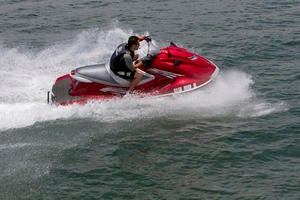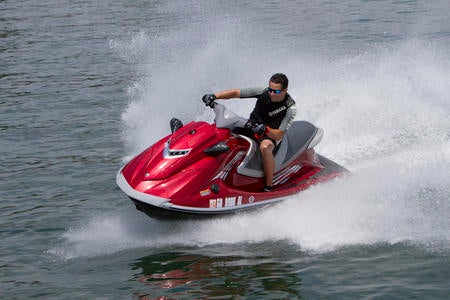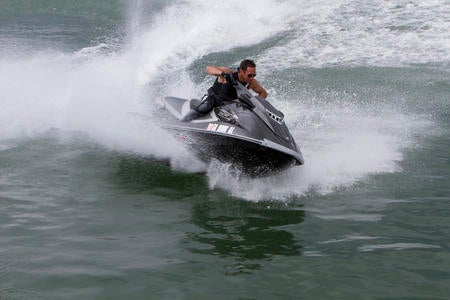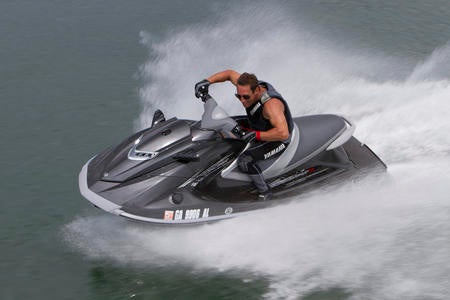2012 Yamaha VXR Review
Pure Performance ... Without The Price
It’s safe to say one of the most eagerly anticipated boats in 2011 was Yamaha’s VXR, an experiment that placed a powerful, but non-supercharged engine in an entry-level, but versatile hull design. The result was a boat that went as fast as the industry’s flagship musclecraft but didn’t carry their same hefty price tag. It also brought a PWC back to its simple, no-frills roots.
Naturally it was a success, and spawned Sea-Doo to follow suit in 2012. Following the “if it ain’t broke, don’t fix it” mantra, virtually that same boat has returned in 2012.
Combo Platter
The mixing and matching of existing components is what makes the VXR continue to be a winner. For starters, there’s the power. Under the seat resides Yamaha’s familiar 1.8-liter, still the largest engine in terms of displacement in the watercraft industry. In this guise, it foregoes the supercharger and intercooler combo, primarily because this lightweight package simply doesn’t need it. I recorded a top speed on my GPS that easily surpassed the 65 mph mark, and noted 0-30 mph acceleration runs in the neighborhood of 1.8 seconds. That puts the VXR right in line with the industry’s leading flagships, and all without their higher fuel bills and maintenance concerns.
 A light-weight hull and Yamaha’s 1.8-liter engine are a winning combination.
A light-weight hull and Yamaha’s 1.8-liter engine are a winning combination.As it turns out, the engine is actually a good match for the VXR hull. Saddled with introductory duties until last year (although VX models have arguably proven popular with far beyond just introductory riders), this platform has always shown potential in the handling department. It handles a variety of conditions with ease, and actually carves a pretty tight corner. In fact, some fine-tuning of the hull’s sponson placement and a shift in the boat’s center of gravity have created a truly agile, aggressive hull. Power into a turn, shift your weight just right, and the boat rockets through the corner with jaw-dropping agility. It’s truly a thrilling ride.
There is, however, somewhat of a learning curve to find that sweet spot. Miss it and you’ll find a little bit of an unnerving skid at full speed, but dial in that position (mine was best if I kept my weight further back toward the stern) and the results are great fun. I also found good results standing up, a position that not so coincidentally also positioned my weight a little further back on the craft.
Tip? Chop the throttle for just a fraction of a second when entering a turn, then power through. The technique plants the bow and uses the hull to maximum effect.
Truth be told, this is not the exact VX hull shared by the rest of the line. Rather, it’s a lightened version that exploits the boat’s power-to-weight ratio to the max. Yamaha used its proprietary NanoXcel hull material in the VXR lay-up. Nano-engineering of the Sheet Molding Compound (SMC) formulation substantially lowers the material’s weight, while according to Yamaha, actually improves hull strength over standard SMC or fiberglass formulations. The VXR weighs a mere 728 pounds. That’s less than even the most minimal VX Sport, which features a far less powerful engine.
No Frills
As ride and speed (and price) are the primary focus, don’t expect to find much in the way of extras. Other than a reboarding step and the familiar remote that locks the craft or activates a slow-speed mode, Yamaha intentionally kept the VXR somewhat plain, foregoing electronic throttle, trim, and even tilt steering. The only addition for 2012 is a choice in color. Riders can now choose between a VXR in Carbon or one in Crimson Red Metallic.
I’ve heard many riders describe this simple approach as almost freeing. Rather than have extras to contend with, they just focus on the ride, much like the days of the no-frills stand-ups.
That may limit the VXR’s audience in some regards … but also likely targets it even more precisely for the crowd it’s intended to reach.
| 2012 Yamaha VXR Specs | |
| Length | 128.7 inches |
| Beam | 46.1 inches |
| Dry Weight | 728 lbs |
| Engine | Four-cylinder EFI |
| Displacement | 1,812 cc |
| Bore and Stroke | 86mm x 78mm |
| Compression Ratio | 11.0:1 |
| Fuel Capacity | 15.9 gal. |
| Combined Stowage Capacity | 15.1 gal. |
| Colors | Carbon or Crimson Red Metallic |
| Price | $11,299 |
Related Reading
2011 Yamaha VXR Review
2012 Yamaha VX Deluxe Review
2012 Yamaha VX Sport Review
2012 Yamaha WaveRunner Lineup Preview [Video]
Get PersonalWatercraft.com in your Inbox!
Like PersonalWatercraft.com on Facebook
Comments
Most Popular

2025 Yamaha JetBlaster PRO 2-Up Review

2024 Kawasaki Jet Ski STX 160X Review

Remembering the Sea-Doo XP

Whatever Happened to the Wetbike?

2025 Yamaha JetBlaster Review














 Your Privacy Choices
Your Privacy Choices